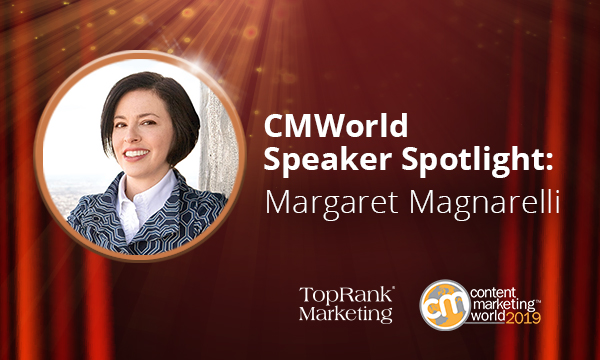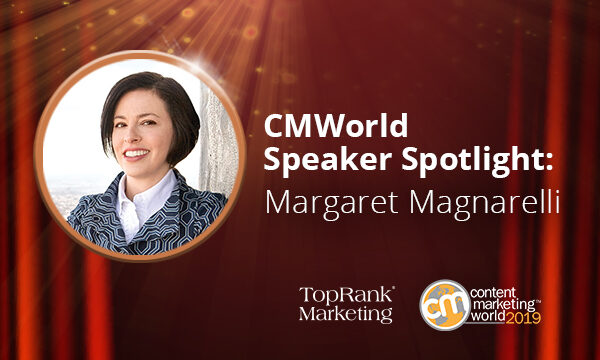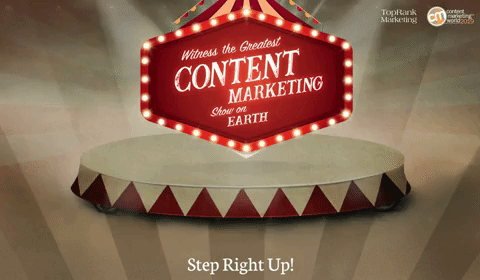
Content marketers come from all sorts of different backgrounds, with each bringing its own distinct and valuable perspective. Recently we shared our chat with Andrew Davis, whose history in television inspires him to think like a TV executive when strategizing his content. Today we’re highlighting the insights of Margaret Magnarelli, whose ingrained journalistic mindset fuels a commitment to putting her audience — and their trust — above all else.
Prior to joining Morgan Stanley as Executive Director for Audience Acquisition and Growth Marketing, Margaret served as Vice President of Marketing for Monster, and before that she spent nearly a decade on the editorial staff at Money Magazine, rising from Senior Editor to Assistant Managing Editor to Executive Editor.
Through this experience, she has developed a keen sense of duty to her audience. She knows that trust is hard-earned and easily lost (or: gained in drops, lost in buckets). This is a central tenet of faithful journalists everywhere. I can attest as a fellow j-school grad: this field holds truth and accuracy as sacred ideals.
At Content Marketing World 2019, Margaret will speak on The Power of Trust: How to Build Credibility with Customers — and Convince Them to Buy. Ahead of her session, she starred in TopRank Marketing and CMI’s CMWorld preview experience, where she declares that in order to put on an unforgettable show for your audience, “Trust is your ticket to admission, and therefore needs to be treated as a main event.”
In an expanded interview with us, Margaret expands on her enlightened viewpoints as they apply to building trust, being mindful of word counts, balancing facts versus feelings, and much more.
Margaret Magnarelli on Putting Your Audience First
1. Congrats on your recent move to a new position! What does your role as Executive Director for Audience Acquisition and Growth Marketing at Morgan Stanley entail?
Thank you! My job focuses on the development of audience using organic channels. I oversee the firm’s social media and SEO strategies, as well as managing projects that help us optimize conversion rates. Basically, I’m thinking about how we introduce new people to our brand, and how we direct those people to the services that will help them.
The backbone of all of this is content that exemplifies Morgan Stanley’s core values: leading with exceptional ideas, giving back, putting clients first, and doing the right thing. These values are the framework for how we serve consumer and institutional clients. I was drawn to the firm because of its focus on relationships as customer experience, its emphasis on content as a driver of marketing, and its commitment to volunteerism and philanthropy.
While my background prior to this job was content development and strategy, I took this role sitting alongside content creation—and an incredible content team—because I wanted to dig deeper into the audience aspects of marketing. After all, you can have the best product to sell and best creative to sell it with, but if you’re not reaching the right audience you aren’t going to be effective.
2. You have a background in journalism. How does this experience influence your views on the importance of trust in content marketing?
I’m definitely predisposed to care about trust from my j-school training. As a journalist, you have a duty to be responsible to your audience—to seek out the most objective truth that is possible and to present an accurate representation of what you learn. I feel that same obligation to my audiences as a marketer. In other words, I think I have a more customer-centric approach because that’s how I was trained in journalism.
Another thing: Journalistic writing requires proof points, whether that’s supporting statistics, expert quotes or telling anecdotes. These same proof points are needed in marketing to support the brand-forward, top-funnel storytelling you need to do to attract initial attention. Immediately after you’ve established contact, you need evidence to show that you have the capability to do what you say you can do; otherwise it’s just fluff.
Journalistic writing requires proof points, whether that’s supporting statistics, expert quotes or telling anecdotes. These same proof points are needed in marketing. @mmagnarelli Share on X3. What other lessons from serving in a magazine editorial role are applicable to your current content focus?
I believe every word counts. You can say the same thing 1,000 different ways, and each one will convey something different to the audience. Simple word choice changes seriously impact perception. So how do you choose? Some of that is gut—“does this feel like our brand?” and “how do we take the way we talk to customers in real life and translate that to digital experience?”—and some is science, like A/B testing language on a conversion module. You can take conversion as a kind of measure of trust.
4. What are some of the biggest credibility-killers you come across when consuming marketing content?
There’s still a lot of marketing content out there that’s basically “why we want to sell you this thing” rather than “how we can help you solve a problem with what we sell.”
Social science indicates that benevolence is a key aspect of trust. Does your content show your audience that you understand their problem and that you have their best interests in mind? This isn’t a heavy lift to incorporate into content—simply acknowledging and validating the problem in your work can go a long way. It’s not hard but you don’t see it done as much as it could be.
In addition, I am not a huge fan of marketing that’s 100% about building a feeling. Today’s consumers are smarter than that. Millennials in particular are a skeptical audience; they can see through the pretty pictures and snarky marketing copy. By all means, take them to an emotional place (aspiration, inspiration, hope, connection, etc.) if that’s right for your brand—but make sure you give them the evidence they need to know that you’re the right choice, that your products work. Show data from independent product studies, include customer reviews, mention third-party awards, share like-customer success stories, offer the option of product walkthroughs.
5. Conversely, what are some tactics and techniques you view as most successful for building customer trust (especially during early engagements)?
Back to the Millennial and Gen Z consumers: All the research shows that they’re looking for brands that align with their values. So transparency is super important. The three main opportunities for transparency are price, process, and provenance. What can you tell your customers about why your services are priced as they are, about how your products were made, and about where they come from?
The three main opportunities for transparency are price, process, and provenance. @mmagnarelli Share on X6. Which digital channels do you recommend prioritizing when it comes to cultivating a credible and authentic brand?
All of them! I think your brand needs to come off as credible consistently for people to trust you. In fact, inconsistency across channels can erode trust, because it may look like you’re saying one thing in one space and something else in another. That said, a good rule of thumb is that the more intimate the medium, the more trust is at stake. Where someone is signing up for an email newsletter from you—where they’ve given up their email address—they expect more from you than they would seeing your content broadcast on a social channel. They expect a value exchange, and whether they get what they thought they would get impacts trust.
I also think the content created for organic search is another key area, since you have the opportunity to attract someone from a side door with a specific intent and zero brand awareness; your answer to their question will have a big impact on whether you can be trusted on more consequential matters. [Editor’s Note: We couldn’t agree more!]
7. Which speakers and/or sessions are you most looking forward to seeing at this year’s Content Marketing World?
You can basically throw a dart at the CMWorld schedule and have an educational and inspirational experience! I’m excited to see old friends and favorites who are too many to name, but I am also going to focus more on SEO and conversion topics this year. Among the ones I hope to attend: Mark Zimmerman from PublicisSapient on SEO and voice, Christopher White from Capital One since it’s a similar financial space, Val Geisler on reducing audience churn, Dennis Shiao on building community, Adam Constantine from Pace on creating compelling social creative, Katie Tweedy on evolving search landscape, Eli Schwartz on growth experimentation, Wally Koval on creating an audience for @accidentallyweanderson.
Change is the only constant in content marketing, and you’ve got to have a growth mindset to continue besting your own results. I also believe in a teaching mindset, as a way of paying it forward for all I’ve learned from others. I know there are tons of people in the audience at CMWorld who have even better ideas than I do, and I hope to see some of them on the stage next year. If you’ve seen results, you have something to share with your peers. Don’t be shy. Your community needs to hear from you!
Change is the only constant in content marketing, and you’ve got to have a growth mindset to continue besting your own results. @mmagnarelli Share on XStep Right Up and Be Amazed!
We’re looking forward to seeing Margaret take the stage on September 4th at CMWorld 2019, where she’ll drive home the power of trust in today’s content marketing landscape.
As we count down the days to the big show, you can get your fill of awesome content marketing insights — from Margaret and many other speakers — by gaining free admission to The Greatest Content Marketing Show on Earth!




